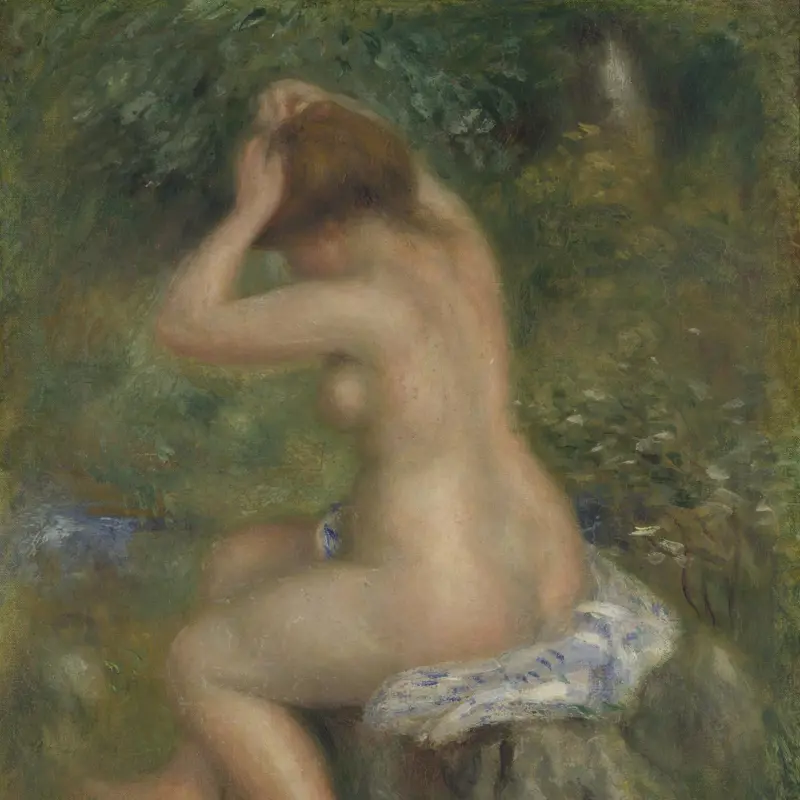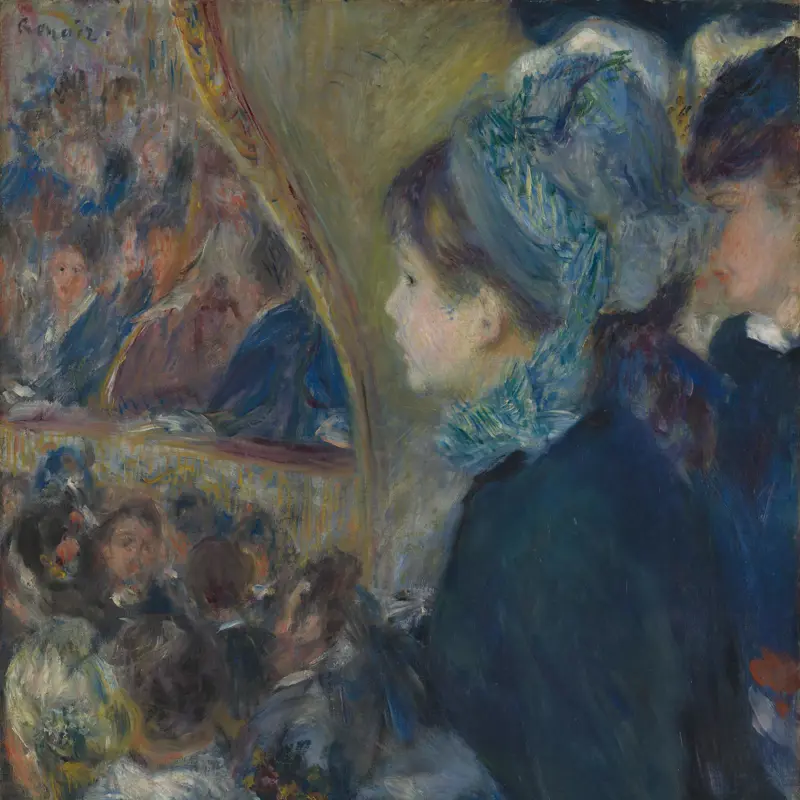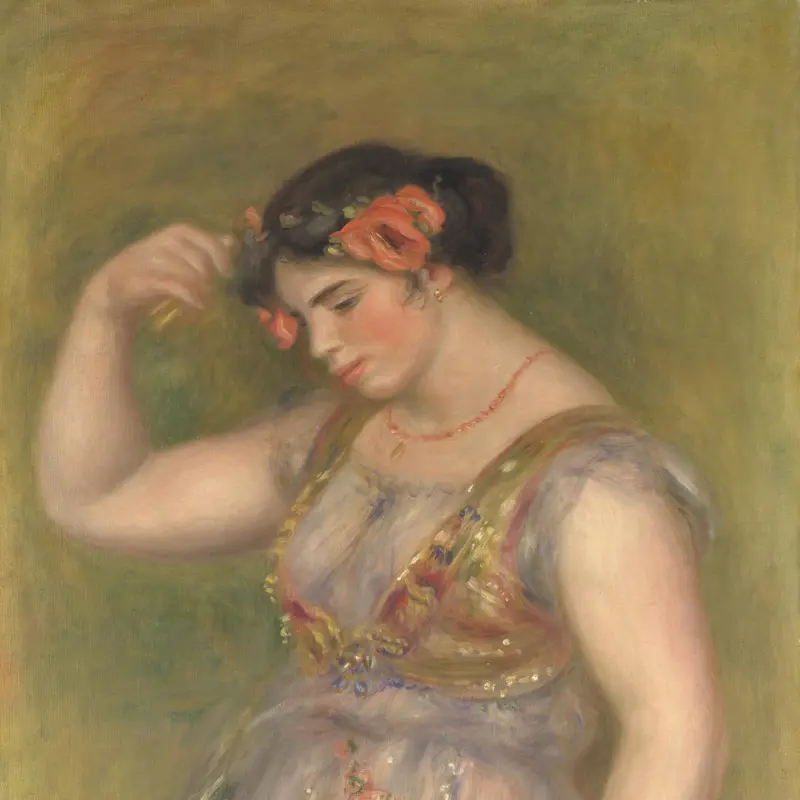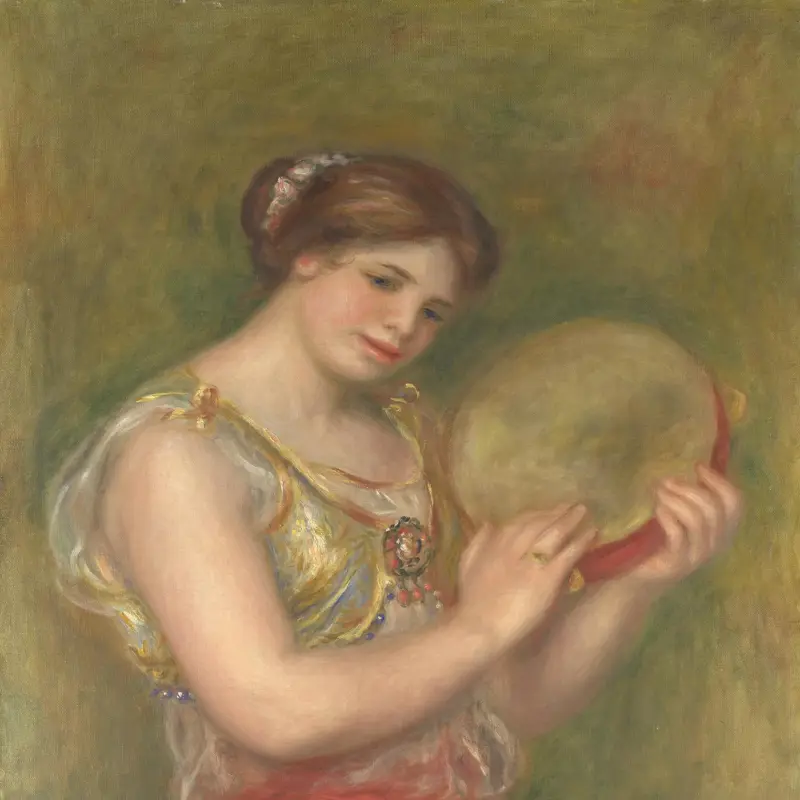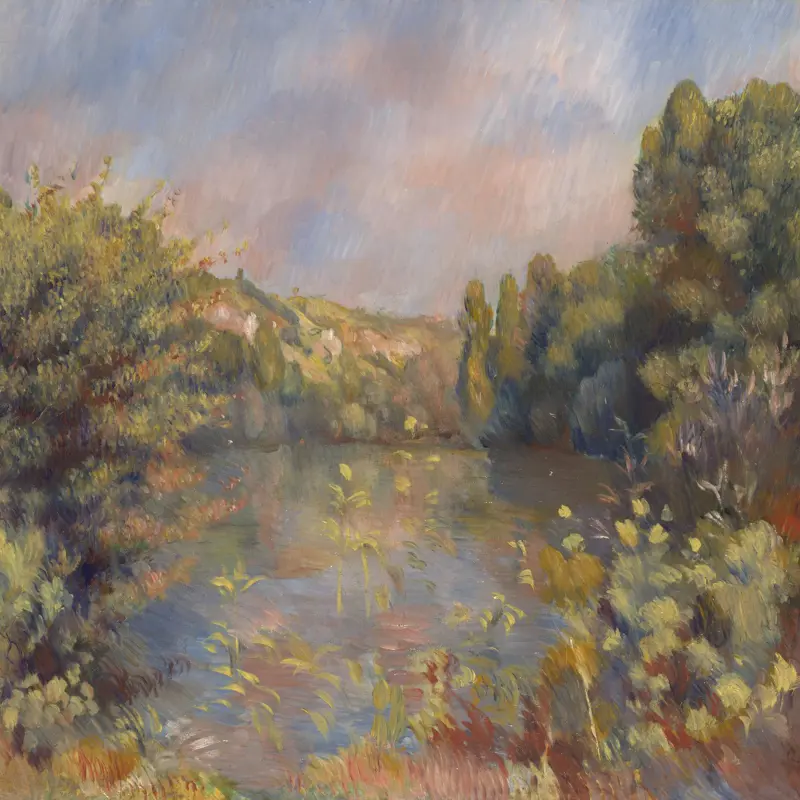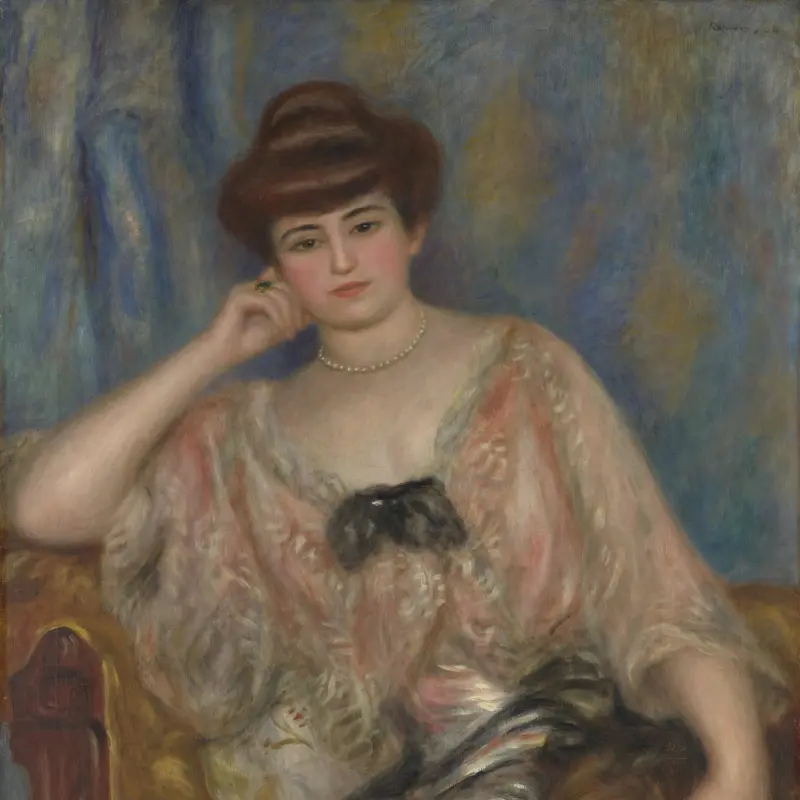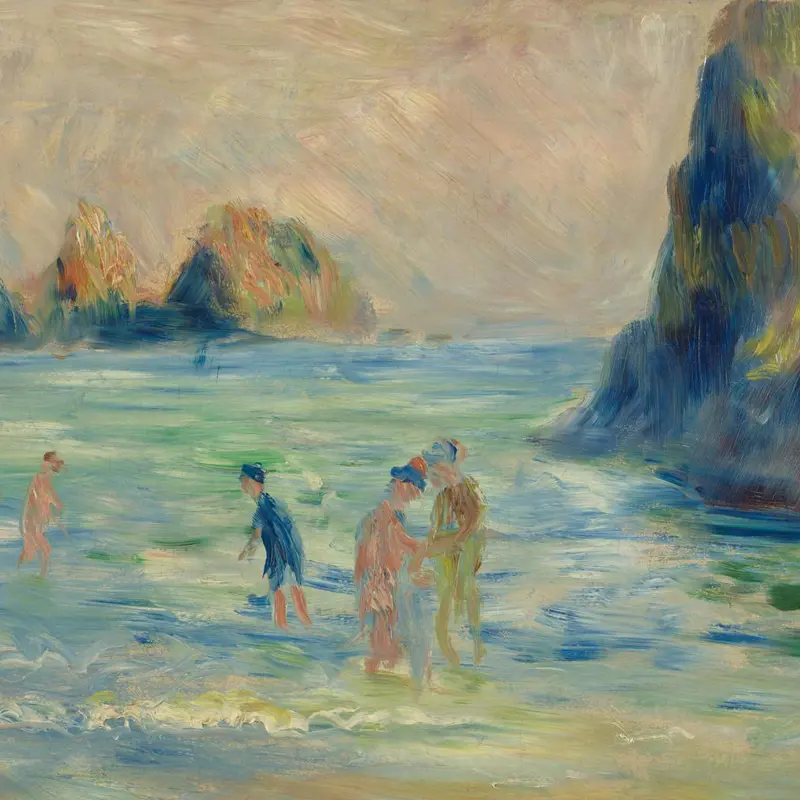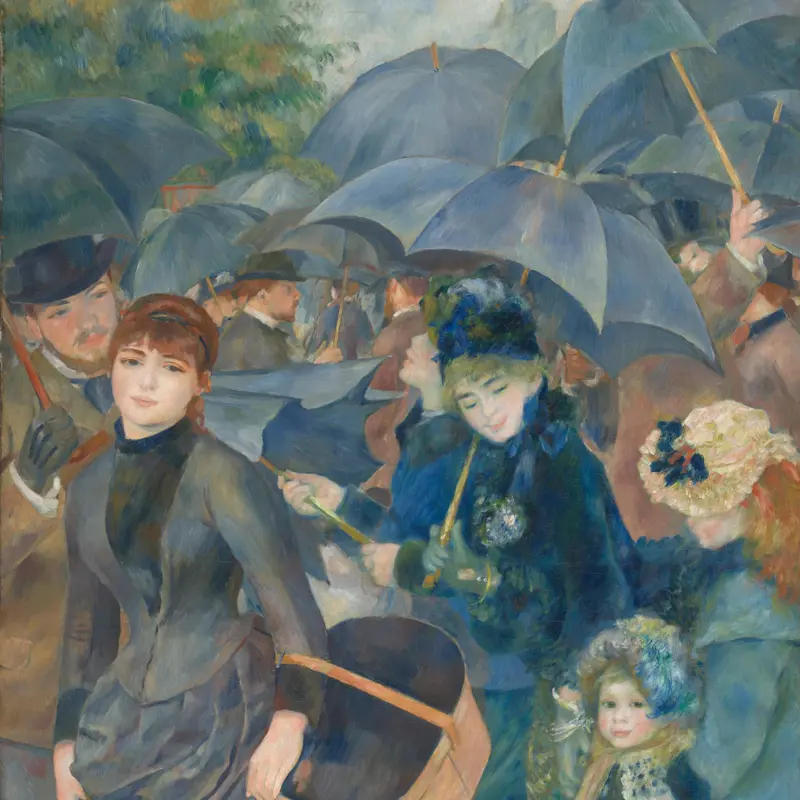Pierre-Auguste Renoir, 'The Skiff (La Yole)', 1875
About the work
Overview
This sunlit scene on the river Seine is typical of the imagery that has come to characterise Impressionism, and Renoir includes several familiar Impressionist motifs such as fashionably dressed women, a rowing boat, a sail boat, and a steam train crossing a bridge. The exact location has not been identified, but we are probably looking at the river near Chatou, some ten miles west of central Paris, which was a popular spot for recreational boating.
If Renoir’s choice of subject is characteristically Impressionist, this is also true of his painting technique. He creates an effect of summer heat and light by using bright unmixed paint directly from the tube and by avoiding black or earth tones. In placing the bright orange boat against the dark blue water, Renoir has deliberately used complementary colours, which become more intense when seen alongside each other.
Key facts
Details
- Full title
- The Skiff (La Yole)
- Artist
- Pierre-Auguste Renoir
- Artist dates
- 1841 - 1919
- Date made
- 1875
- Medium and support
- oil on canvas
- Dimensions
- 71 × 92 cm
- Inscription summary
- Signed
- Acquisition credit
- Bought, 1982
- Inventory number
- NG6478
- Location
- Room 41
- Collection
- Main Collection
- Frame
- 18th-century English Frame
Provenance
Additional information
Text extracted from the National Gallery’s Annual Report, ‘The National Gallery Report: January 1982 – December 1984’.
Exhibition history
-
2008Long Loan to the Van Gogh Museum (2008 - 2010)Van Gogh Museum18 November 2008 - 11 January 2010
-
2013Normandie ImpressionnisteMusée des Beaux-Arts (Rouen)27 April 2013 - 29 September 2013
-
2014Making ColourThe National Gallery (London)18 June 2014 - 7 September 2014
-
2018Courtauld Impressionists: From Manet to CézanneThe National Gallery (London)17 September 2018 - 20 January 2019
-
2019The Courtauld Collection. A Vision for ImpressionismFondation Louis Vuitton20 February 2019 - 17 June 2019
Bibliography
-
1926G. Coquiot, Renoir, Paris 1926
-
1927Bernheim-Jeune, Cinquante Renoir choisis parmi les nus, les fleurs, les enfants, Paris 1927
-
1929Lefevre Galleries, Ten Masterpieces by XIXth Century French Painters, Glasgow 1929
-
1932P. Jamot and P.M. Turner, Collection de tableaux français faite à Londres 20 Portman Square par Samuel et Elisabeth Courtauld, 1914-1931, London 1932
-
1954D. Cooper, The Courtauld Collection: A Catalogue and Introduction, London 1954
-
1963Wildenstein, The French Impressionists and some of their Contemporaries (exh. cat., Wildenstein, 24 April 1963 - 18 May 1963), London 1963
-
1969J. Rewald, 'Chocquet and Cézanne', Gazette des beaux-arts, 1969
-
1976W. Pach, Auguste Renoir: Leben und Werk, German edn, Köln 1976
-
1982W. Gaunt, Renoir, Oxford 1982
-
1985National Gallery, The National Gallery Report: January 1982 - December 1984, London 1985
-
1985A. Roy, 'The Palettes of Three Impressionist Paintings', National Gallery Technical Bulletin, IX, 1985, pp. 12-20
-
1985C.P. Schneider, 'Renoir: Le peintre de figures comme paysagiste', Apollo, 1985, pp. 49-56
-
1985J. Rewald, 'Chocquet and Cézanne', in J. Rewald, Studies in Impressionism, London 1985, pp. 121-87
-
1988R.L. Herbert, Impressionism: Art, Leisure and Parisian Society, New Haven 1988
-
1988F. Cachin and B. Welsh-Ocharov, Van Gogh à Paris, (exh. cat. Musée d'Orsay, 2 February - 15 May 1988), Paris 1988
-
1990D. Bomford, R. White and L. Williams, Impressionism (exh. cat. The National Gallery, 1990), London 1990
-
1993R. White and J. Pilc, 'Analyses of Paint Media', National Gallery Technical Bulletin, XIV, 1993, pp. 86-94
-
1994J. House, Impressionisim for England: Samuel Courtauld as Patron and Collector, London 1994
-
1996K. Rothkopf et al., Impressionists on the Seine: A Celebration of Renoir's Luncheon of the Boating Party (exh. cat. Phillips Collection, 21 September 1996 - 9 February 1997), Washington 1996
-
1997J. Leighton and R. Thomson, Seurat and the Bathers, (exh. cat. The National Gallery, 2 July - 28 September 1997), London 1997
-
2001
C. Baker and T. Henry, The National Gallery: Complete Illustrated Catalogue, London 2001
About this record
If you know more about this work or have spotted an error, please contact us. Please note that exhibition histories are listed from 2009 onwards. Bibliographies may not be complete; more comprehensive information is available in the National Gallery Library.

